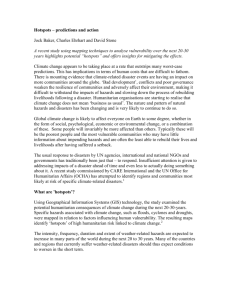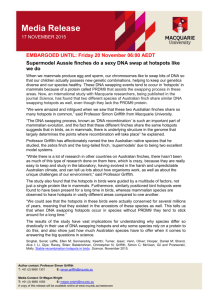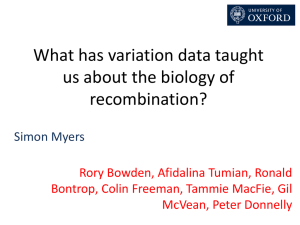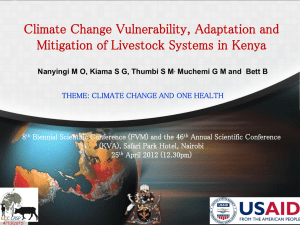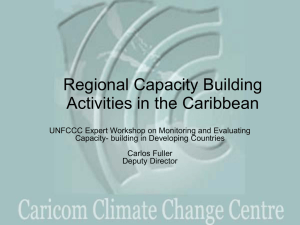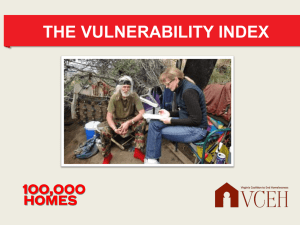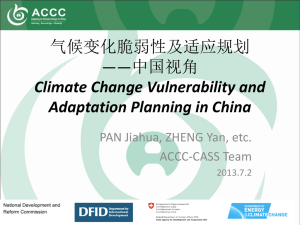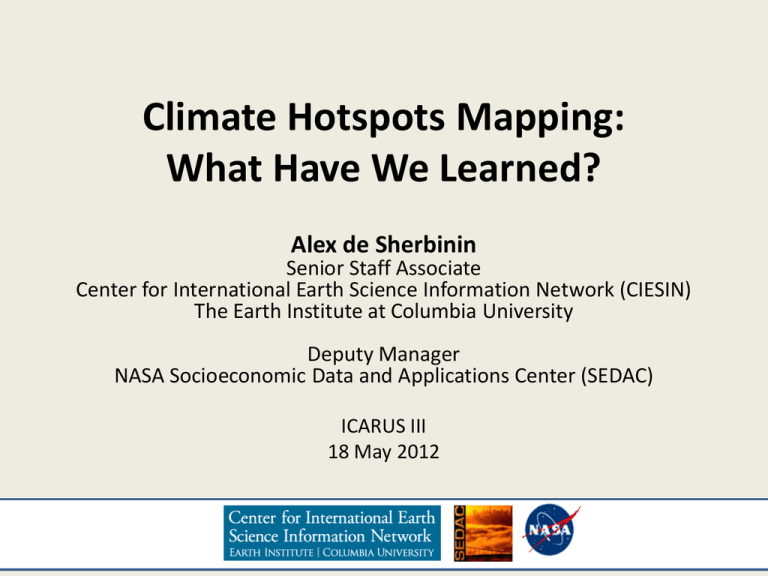
Climate Hotspots Mapping:
What Have We Learned?
Alex de Sherbinin
Senior Staff Associate
Center for International Earth Science Information Network (CIESIN)
The Earth Institute at Columbia University
Deputy Manager
NASA Socioeconomic Data and Applications Center (SEDAC)
ICARUS III
18 May 2012
Outline
•
•
•
•
What is a hotspot?
Why map hotspots?
Preliminary meta-analysis of hotspots mapping efforts
Lessons learned and issues
What is a hotspot?
• Term derived from early work by Norman Myers to
identify areas at risk of biodiversity loss
– Wikipedia: “A biodiversity hotspot is a biogeographic region with
a significant reservoir of biodiversity that is under threat from
humans”
The original
hotspots
map
Source: Myers, N. 1988. Threatened biotas: “Hot spots” in tropical forests.
The Environmentalist 8 187-208.
What is a climate change hotspot?
• Integrates spatial variability in:
– Climate or biophysical systems
– Human pressures or vulnerabilities
Drought Frequency
Poverty Levels
Land Cover Map
Societal Impacts
• Climate change impacts are
spatially differentiated
• Vulnerabilities are spatially
differentiated
• Adaptive/coping capacities are
spatially differentiated
Mapping can illuminate key
vulnerabilities in the coupled
human-environment system and,
in turn, inform where adaptation
may be required
Why map hotspots?
• At a time of increasing pressure on donors and development
organizations to show that scarce public resources are being
used in a responsible manner, spatial indicators and hotspots
maps hold the promise of transparent and, more importantly,
“scientific” and defensible priority setting
– “Enhancing disaster-risk reduction before a disaster occurs, and also
during the reconstruction process, requires enhanced knowledge
regarding the most vulnerable groups, the areas at risk and the driving
forces that influence and generate vulnerability and risk.” Birkmann 2007
• Hotspots maps are also developed to raise awareness among
the general public and high-level policy audiences
• The actual goals generally differ depending on the project
Methodology
• This paper focuses on hotspots analyses that:
– Are at global or regional scales
– Are not national scale indicators
• Examples of the latter include Yohe et al. 2006., Wheeler 2011, and
Population Action International 2011
• Summarized efforts according to purpose, audience,
analytical framework, methods, and hotspots identified
• The work is preliminary and feedback is very welcome!
Mapping methods and themes
1. Climate scenarios
2. GIS data integration
a) Creation of spatial indicators and indices
b) Use of GIS data to tell a story
3. Expert judgment (free hand mapping)
Theme 1
Theme 2
Climate hot
Focus on
spots based on
vulnerable
climate variables populations and
migration
Theme 3
Theme 4
Natural
disasters,
humanitarian
crises and
conflict
Agriculture,
livelihoods, food
security, and
ecosystem
services
Common caveat: “Given the extreme complexity of climate change and
human vulnerability, this study should be considered as indicative only. We
have taken a pragmatic approach in order to produce useful results and
analysis within the scope and resources of this project.”
– Thow & de Blois 2008
IPCC Working Group 2
Definition of Vulnerability
“Vulnerability is the degree to which a system is susceptible to, or unable to
cope with, adverse effects of climate change, including climate variability and
extremes. Vulnerability is a function of the character, magnitude and rate of
climate change and variation to which a system is exposed, its sensitivity, and
its adaptive capacity.”
Population’s Vulnerability = f (E, S, A)
Where
•E = exposure — size of the area and/or population affected (does the event
occur there?)
•S = sensitivity — the intrinsic (age, sex, SES, ethnicity, livelihood strategies,
etc.) and extrinsic (institutions, entitlements, etc.) characteristics of a population
•A = adaptive capacity — capacities of the population, place or system to resist
impacts, cope with losses, and/or regain functions
Type 1. Regional Climate Change Index
• A relative
indicator of
change in
precip and
temp from
1960-79 to
2080-99
• Based on
multi-model
ensembles
for A1B, B1,
and A2
scenarios
Source: Giorgi, F. 2006. Climate change hot-spots, Geophysical Research Letters, 33, L08707
Type 2a. Humanitarian implications of climate change
Source: CARE and Maplecroft. 2008. Humanitarian implications of climate
change: Mapping emerging trends and risk hotspots. Geneva, Switzerland:
CARE International.
• Uses combination
of historical
country-level data
(refugees/displacement, conflict) and
CIESIN’s gridded
data for population,
poverty and climate
hazard exposure
• Climate scenario
data (A1B) for: %
change in extreme
precip, % change
in maximum dry
periods, and future
dynamics of
drought risk
Type 2a. Vulnerability profiles in drylands
Uses integrated
assessment
modeling to answer
questions:
•
•
•
•
•
What are main
exposures, vulnerable
groups and their
sensitivities?
What are V creating
mechanisms?
Where do they
manifest?
How will future
changes affect
wellbeing?
What coping/
adaptation responses
are possible?
Source: Kok, M.T.J., M.K.B. Lüdeke, T. Sterzel, P.L. Lucas, C. Walter, P. Janssen and I. de Soysa. 2010.
Quantitative analysis of patterns of vulnerability to global environmental change. Den Haag/Bilthoven,
Netherlands: Netherlands Environmental Assessment Agency (PBL).
Type 2a. Climate change vulnerability mapping in
Southeast Asia
Applies IPCC
framework. Uses
proxies for exposure
(climate hazards),
sensitivity
(population and
PAs), and adaptive
capacity (HDI,
poverty, income
inequality, electricity
coverage, irrigated
area, road density,
and communications
infrastructure)
Source: Giorgi, F. 2006. Climate change hot-spots, Geophysical Research Letters, 33, L08707
Type 2a. Climate change and African political stability
Four baskets of vulnerability are
identified: exposure to climate
hazards, population density,
household and community
resilience (health, education,
access to health care), and
governance and political violence
(country level indicators of
government responsiveness,
effectiveness, polity, and violence
against civilians)
Source: Busby, J.W., T.G. Smith, and K.L. White. 2011. Locating Climate Insecurity: Where are the most
vulnerable places in Africa? Climate Change and African Political Stability Program Policy Brief No. 3.
Type 2a. Risk and vulnerability mapping in Southern
Africa
• Combines exposure (climate
hazards such as droughts,
floods, rainfall variability),
future exposure (ensemble
climate model precip, temp
change and SLR), sensitivity
(irrigated lands, crowding on
agricultural lands, length of
growing period, soil
degradation, etc.), and
adaptive capacity (night-time
lights, education, malaria
index, HIV prevalence,
accessibility, etc.)
• Climate impacts
Source: Davies, R.A.G., and S.J.E. Midgley. 2010. Risk and Vulnerability Mapping in Southern Africa: A
Hotspots Analysis. Cape Town, South Africa: OneWorld Sustainable Investments (Pty) Ltd.
Type 2b. Climate-migration hotspots
Source: Warner, K., C. Erhart, A. de Sherbinin, S.B. Adamo, T.Chai-Onn. 2009. In search of Shelter:
Mapping the effects of climate change on human migration and displacement. Bonn, Germany: United
Nations University, CARE, and CIESIN-Columbia University.
Type 2b. Climate-migration hotspots
Source: Warner, K., C. Erhart, A. de Sherbinin, S.B. Adamo, T.Chai-Onn. 2009. In search of Shelter:
Mapping the effects of climate change on human migration and displacement. Bonn, Germany: United
Nations University, CARE, and CIESIN-Columbia University.
Type 2b. Sea level rise displacement
Source: McGranahan, G., D. Balk and B. Anderson. 2007a. The rising tide: assessing the risks of climate
change and human settlements in low elevation coastal zones. Environment & Urbanization 19(1): 17-37.
Type 3. Security risks associated with CC
Source: Schubert, Schellnhuber, et al. 2007. Climate Change as Security Risk. London: Earthscan.
Type 3. CC and Political Instability Hotspots
Source: Scheffran J & Battaglini A (2011) Climate and conflicts: the security risks of global
warming. Regional Environmental Change 11(Suppl 1):S27-S39.
Type 3. Climate refugee hotspots
Deltas
Small Islands
Coastlines under threat
Desertification and Drought
Hurricanes
Arctic areas with permafrost melt
Source: Emmanuelle Bournay, UNEP-GRID Arendal, Fifty million climate refugees by 2010
http://www.grida.no/graphicslib/detail/fifty-million-climate-refugees-by-2010_71db
Climate Change & Population Vulnerability
Climate Change & Population Vulnerability
CC & Security, CC & Agriculture
Hotspots mapping: Data issues
• Uncertainties in climate scenarios
– Coarse resolution of climate models (AR5 may improve on this)
– Uncertainties in emissions scenarios and climate sensitivity
– Limited ability to capture extremes in temp or precipitation
• Uncertainties and other issues with non-climate data
– Temporal inconsistencies (regular remote sensing observations
and future climate projections vs. “static” socioeconomic data)
– Inconsistent definitions or measurements across countries
– Spatial and scale mismatches (coastlines/boundaries)
– Non-existent or inappropriate data
• Reuse for other purposes may lead to unexpected problems
• Data may exist but be too costly or poorly documented to use
Hotspots mapping efforts generally extrapolate from current vulnerability to
climate variability and extremes to identify how climate change may alter the
climate component, leaving aside changes in systems, sectors and groups that
will be impacted
Hotspots mapping: Other issues
• In GIS analysis, combinations of country-level,
subnational and continuously varying variables such as
precipitation leads to disjuncture at national borders
• There is little ability to compare results because each
effort is focused on different dependent variables (e.g.
migration, conflict, agriculture)
• The maps can tell a useful story, but as with any
indicators, if results do not conform to the policy maker’s
own mental models, they may not be widely accepted
Concluding Thoughts (1)
• Hotspots mapping is characterized by methodological
diversity
• Data limitations mean that most authors characterize the work
as “preliminary” or “broadly indicative”
• There are many assertions that the results are policy relevant
• Yet, there is little evidence that the hotspots maps are actually
being used for prioritization of adaptation funding
– Some mapping efforts are funded by donors, so they may be using the
maps internally
Concluding Thoughts (2)
• Like most indicators, they contribute to the framing issues:
– “Scientific assessments, evaluations, scenarios and the like often
influence policies indirectly and through largely unforeseen pathways,
e.g. by gradually shaping frameworks of thought.” (POINT 2011: 7)
– “indicators also represent particular ways to conceptualize problems
and solutions. Indicators are not merely technical or “innocent”
instruments for stronger surveillance and reporting. They are also
elements in what has been termed as a political struggle over the
contents of the process of ‘ecological modernization’ of society.”
(Gudmundson 2003, Hajer 1992)
Thank You!
amd155@columbia.edu

